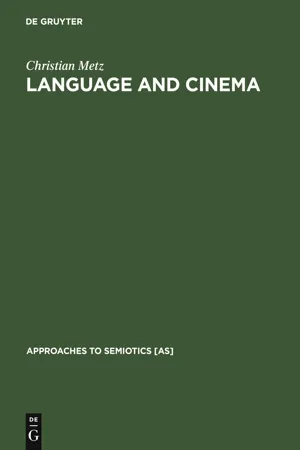
- 303 pages
- English
- PDF
- Available on iOS & Android
eBook - PDF
Language and Cinema
About this book
No detailed description available for "Language and Cinema".
Frequently asked questions
Yes, you can cancel anytime from the Subscription tab in your account settings on the Perlego website. Your subscription will stay active until the end of your current billing period. Learn how to cancel your subscription.
At the moment all of our mobile-responsive ePub books are available to download via the app. Most of our PDFs are also available to download and we're working on making the final remaining ones downloadable now. Learn more here.
Perlego offers two plans: Essential and Complete
- Essential is ideal for learners and professionals who enjoy exploring a wide range of subjects. Access the Essential Library with 800,000+ trusted titles and best-sellers across business, personal growth, and the humanities. Includes unlimited reading time and Standard Read Aloud voice.
- Complete: Perfect for advanced learners and researchers needing full, unrestricted access. Unlock 1.4M+ books across hundreds of subjects, including academic and specialized titles. The Complete Plan also includes advanced features like Premium Read Aloud and Research Assistant.
We are an online textbook subscription service, where you can get access to an entire online library for less than the price of a single book per month. With over 1 million books across 1000+ topics, we’ve got you covered! Learn more here.
Look out for the read-aloud symbol on your next book to see if you can listen to it. The read-aloud tool reads text aloud for you, highlighting the text as it is being read. You can pause it, speed it up and slow it down. Learn more here.
Yes! You can use the Perlego app on both iOS or Android devices to read anytime, anywhere — even offline. Perfect for commutes or when you’re on the go.
Please note we cannot support devices running on iOS 13 and Android 7 or earlier. Learn more about using the app.
Please note we cannot support devices running on iOS 13 and Android 7 or earlier. Learn more about using the app.
Yes, you can access Language and Cinema by Christian Metz, Donna Jean Umiker-Sebeok in PDF and/or ePUB format, as well as other popular books in Languages & Linguistics & Linguistics. We have over one million books available in our catalogue for you to explore.
Information
Table of contents
- 1. Within the Cinema : The Filmic Fact
- 2. Within the Filmic Fact: The Cinema
- 2.1. ‘Cinema’ in another sense
- 2.2. From material to codical homogeneity: a premature conclusion
- 2.3. The same code in several ‘language systems’; several codes in the same ‘language system’
- 2.4. Cinematic specificity, cinematic language system (I)
- 2.5. Cinematic-filmic, cinematic-non-filmic, filmic-non-cinematic
- 3. Film in an Absolute Sense
- 3.1. ‘The Film’/‘The Cinema’
- 3.2. The zone common to the film and cinema. Its limits
- 4. Plurality of Cinematic Codes
- 4.1. General and particular codes
- 4.2. Plurality along two axes
- 4.3. ‘Cinematic language system’ (II)
- 5. From Code to System; Message to Text
- 5.1. ‘The study of films’: two different approaches
- 5.2. Code/singular system
- 5.3. General and particular codes (II)
- 5.4. Terminological points
- 5.5. ‘Structure of the message’ or structure of the text?
- 6. Textual Systems
- 6.1. The film as a unique totality
- 6.2. The system of the film as displacement
- 6.3. Cinematic and extra-cinematic: from duality to mixture
- 6.4. Readings: several textual systems for a single text
- 7. Textuality and ‘Singularity’
- 7.1. Filmic texts smaller or larger than a film
- 7.2. Group of films and class of films
- 7.3. From ‘particular code’ to sub-code (III)
- 7.4. The pansemic tendency of certain figures
- 7.5. Code/sub-code (IV)
- 7.6. The systemic and the textual
- 7.7. Textuality and generality
- 7.8. ‘Film’ in the absolute sense (II)
- 8. Paradigmatic and Syntagmatic
- 8.1. The syntagmatic and the textual
- 8.2. The syntagmatic and the paradigmatic; syntagmatics and paradigmatics
- 8.3. Degrees of preexistence of the ‘object studied’
- 8.4. Circularity of paradigmatics and syntagmatics
- 8.5. Syntagmatic and consecutive
- 8.6. Paradigmatic and syntagmatic in textual systems
- 9. The Problem of Distinctive Units
- 9.1. Several types of minimal units in the same text
- 9.2. Several types of cinematic units in the film
- 9.3. The determination of minimal units and the overall study of grammar
- 9.4. Several types of extra-cinematic units in the film
- 9.5. Distinctive units: diversity of size
- 9.6. Distinctive units: diversity of form
- 9.7. Critique of the notion ‘cinematic sign’
- 10. ‘Specific/Non-Specific’: Relativity of the Classification Used
- 10.1. ‘Form/material/substance’ according to Hjelmslev
- 10.2. Semiotic interference between language systems
- 10.3. Distinctive features of the material of the signifier
- 10.4. The intermixing of specificities: Multiple specificity, degrees of specificity, modes of specificity
- 10.5 Cinema and television
- 10.6. Language system as a combination of codes
- 10.7. Non-specific codes. Codes of content and codes of expression
- 10.8. Hjelmslev reconsidered: ‘substance’
- 11. Cinema and writing
- 11.1. Cinema and writing as recordings
- 11.2. Cinema and writing as transmissions
- 11.3. Cinema and writing as ‘printings’
- 11.4. Cinema and writing as ‘compositions’
- 11.5. The cinema in relation to the ‘writings’ of Writing Degree Zero
- 11.6. Cinema and ideography
- Conclusion: Cinematic Language System and Filmic Writing
- References
- Subject index
- Index of Names
- Index of Films